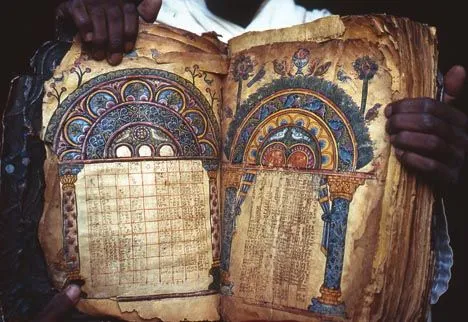The oldest, most complete bible on Earth. The Ethiopian bible, which was written on goat skin, was the world’s first illustrated Christian Bible and was written around the early fifth century.

A British charity has preserved the world’s earliest illustrated Christian book, found at a secluded Ethiopian monastery.
The Remarkable Garima Gospels
These remarkable texts, known as the Garima Gospels, are attributed to a monk named Abba Garima who arrived in Ethiopia in the fifth century. According to legend, he copied the Gospels in just one day.

Vivid Illustrations and Preservation Efforts
The Gospels are beautifully illustrated with vibrant colors, preserved by the Ethiopian Heritage Fund. Abba Garima, who came from Constantinople in 494 AD, is believed to have copied the texts in one day due to divine intervention that delayed sunset.
Historical Significance and Preservation
The Garima Gospels have been housed in the Garima Monastery near Adwa in Tigray, at an elevation of 7,000 feet. Experts consider it the oldest example of bookbinding with its original pages intact. Despite numerous invasions and a church fire in the 1930s, the Gospels have survived.
Ancient Texts on Goat Skin
Written on goat skin in Ge’ez, an early Ethiopian language, the Garima Gospels consist of two volumes. Although the volumes are from the same period, they were written by different hands and include illustrations of the four Gospels.

Rediscovery and Conservation
Previously thought to date from the 11th century, carbon dating has placed the Gospels between 330 and 650 AD, overlapping with Abba Garima’s arrival in Ethiopia. The Ethiopian Heritage Fund played a crucial role in their discovery and conservation, obtaining rare access to the texts.
Future Hopes for the Gospels
The Gospels are set to be displayed in a museum at the monastery, allowing visitors to view these historic texts. Blair Priday from the Ethiopian Heritage Fund emphasized the significance of Ethiopia as a source of ancient Christian relics, many of which are located in remote monasteries accessible only by arduous journeys.
Conservation Efforts
The 1960s restoration of the Gospels involved crude stitching, causing damage to the pages. The Ethiopian Heritage Fund’s efforts have ensured the texts are preserved and accessible. Priday highlighted the importance of preserving Ethiopia’s cultural heritage to boost visitor revenue and appreciation of the country’s rich history.



